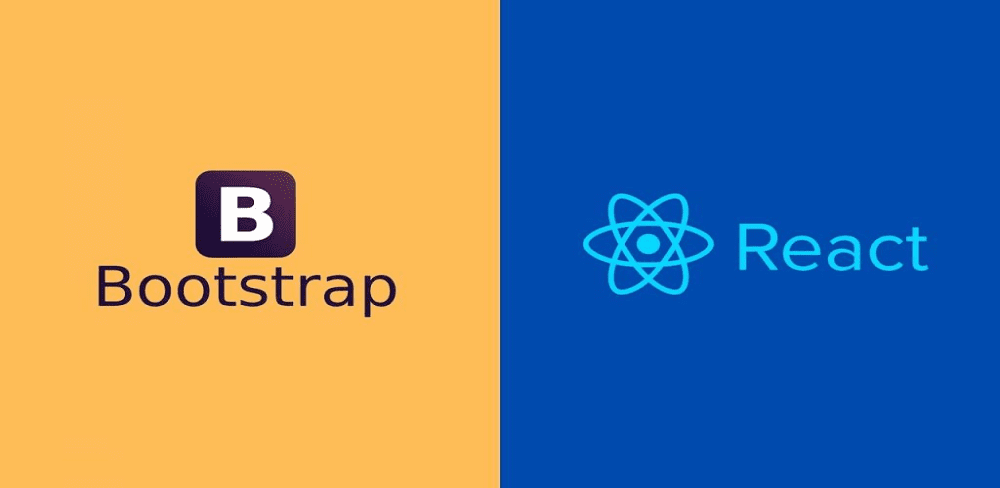Choosing a correct front-end framework is a difficult task After defining the client’s requirements, Front-end developers are faced with a challenging task. The benefits of innovation and upgrading a range of capabilities to make a business grow and gradually benefit. Bootstrap is a popular Frontend Framework that’s competing with React. This text can be used as a guide to compare Bootstrap and React.
We will take a deep dive into the Frontend system whirlpool to determine which structure best suits your project. Bootstrap vs React is a popular topic among developers. UI UX has become a must-have for companies, as it helps to build client loyalty and memory.
Bootstrap and React are two front-end frameworks that allow developers to build sites with advanced design. This results in a superior client experience and a business arrangement.
What is BootStrap?
Bootstrap is also known as Twitter Bootstrap. It’s an open-source CSS front-end framework that allows you to build responsive, mobile-first sites. Bootstrap’s front-end template is primarily CSS. Bootstrap is a popular UI framework because of its frameworks, grids, and responsive design templates.
This framework was created by Mark Otto, Jacob Thornton, and others to standardize framework usage across Twitter personnel. The framework became known as Twitter Bootstrap. The developers released this project to the public on GitHub in 2011.
Market Usage Statistics
Bootstrap is used in a variety of interesting ways.
- By May 2022, Bootstrap will have been downloaded by approximately 4,25 million web developers.
- Bootstrap will be used by 21,7% of websites until May 2022.
- Bootstrap is ranked 2nd in terms of popularity, traffic, and market share with 14,38%.
What is React?
React is a very well-liked JavaScript package that enables the creation of user interfaces. Facebook created React, which enables developers to create reusable UI components that react fast to data updates and changes. It uses a component architecture that allows developers to break complex UIs down into smaller and more manageable pieces. React makes use of a virtual DOM to optimize rendering performance.
This is done by updating only necessary components whenever the data changes. The declarative syntax makes it easier to maintain and understand code. React is a potent tool for building server-side rendering, mobile apps, and single-page apps. It provides a wide range of frameworks and technologies that provide web development projects flexibility and scalability. Developers can rapidly and effectively construct dynamic, interactive user interfaces with React.
Market Usage Statistics
Here are some interesting market statistics about React.
- React is used by 60% of developers, according to the 2018 State of Developer Ecosystem report.
- React is the most popular framework in Stackflow’s 2021 “Most Loved Frameworks” list, with almost 71 percent. StackOverflow has a 22.4% share of “Topmost Wanted Frameworks”.
- The framework has over 183k Github Stars along with a continuously progressive community.
Bootstrap vs React-Advantages
Advantages of Bootstrap
1. Bootstrap can be easily adapted and is extremely easy to use
Bootstrap allows the creators to be creative. Bootstrap is a CSS framework with predefined classes that allows designers to design using its cross-sectional system, CSS fragments, and JavaScript capabilities.
These are composed, and the planner is flexible and has the option to use only the classes that are anticipated in the markup.
2. Save time and effort
You can have fun making your first web application without any prior preparation. Web applications can only be one page long and a maximum of six pages.
Let’s say you want to create a web application with multiple pages. This type of tool kit allows the designer to speed up the development cycle of web apps.
3. Bootstrap receives regular updates
Bootstrap offers more updates than other structures. Bootstrap updates are delivered regularly and reliably, so you can be sure that you’re working with the most recent devices. When a problem is encountered, the bootstrap improvement team will begin submitting it to the framework.
4. Responsiveness
We all know how important it is to have a responsive website design that will work on any device, be it a tablet, a mobile phone, or a desktop.
Bootstrap makes it easy to create a first site that is versatile. The Bootstrap framework automatically adjusts your website format so that it displays correctly on all screen sizes.
The need for a responsive website is not an extravagance, but rather a necessity as cell phones continue to grow and develop.
5. Platform compatible
Bootstrap is a great solution for the rapid advancement of site development and the desire to create a website that works on any device. It uses CSS and JavaScript which are compatible with most gadgets.
Advantages of React
1. Highly productive
Web applications developed by reacting are highly productive. React is quickly becoming the dominant web structure.
Each time you make a change in a react web application, the virtual DOM will be refreshed. There are also two types of virtual DOM stored in React memory.
2. SEO Friendly
React is a library that’s SEO-friendly and focuses on speed. This is no longer an issue, thanks to the virtual DOM.
JavaScript-based websites can have issues due to DOM redelivery. The site may be experiencing issues due to a long stacking time.
3. Component-based Architecture
Vanilla Javascript applications are expected to go through a phase where dealing with the information of a client program becomes a headache for engineers. It is difficult to maintain vanilla Javascript with the complexity and information of an application developer.
4. Flourishing Communities
Respond has a solid local support system, and this can be attributed to its open-source nature. You may be confident that the neighborhood is always ready to assist you, whether it’s with a problem, bug, or anything else.
Bootstrap vs React-Disadvantages
Disadvantages of Bootstrap
1. Computational Intensity
Bootstrap can be computationally demanding because it involves a large number of resamples. This requires sampling repeatedly with replacement, and then performing the analysis for each resample. It could take a while, especially if you’re working with complicated models or a lot of data.
2. Sampling Error
Bootstrap makes the supposition that the dataset is a good representation of the population as a whole. If the original dataset is biased or does not accurately represent the population, then the resampled data may inherit these biases. The results can be inaccurate or misleading.
3. Overfitting
If the sample size of Bootstrap is small, it can lead to an overfitting. As the resamples have been drawn using replacement, certain observations may appear more than once in a bootstrap sample while others may not be included at all. It can lead to over-representing some data points and an overly optimistic estimation of the model’s performance.
4. Dependence on Sample Size
Bootstrap performance is dependent on sample size. The number of unique resamples is limited when the sample size is small. This can reduce the accuracy of bootstrapping estimates by reducing their variability.
5. Assumption of Independence
Bootstrap assumes the distribution of observations is independent and uniform (IID) in the dataset. This assumption can be broken in some cases, for example when working with spatial or time series data. In these situations, bootstrapping might not be suitable or require further modifications.
Disadvantages of React
1. Inadequate documentation
React can be enhanced with a variety of libraries and tools. Even React is regularly updated. This has a downside. There is simply not enough time to write complete documentation due to the constant updates and releases. The only documentation available to developers is a sparse, text-based guide that doesn’t go into detail.
2. Development Speed
This may be perceived as a negative even though it is an upside. It is because of the constant evolution of the library, which makes developers unhappy with the need to constantly re-learn processes or new mechanics.
3. JSX
JSX is seen by most as a benefit, not a drawback, but it can also be viewed as an obstacle. What is JSX, then? JSX, in simple terms, is a JavaScript Extension that makes the code cleaner and more readable.
It seems like there are nothing but upsides. React is more difficult to understand because of the HTML and JavaScript mix in JSX. This may not be appealing to aspiring developers. JSX can be removed for those who find the coding too challenging.
4. SEO Problems
SEO is also included in the positives. Why then is it listed as a con? Google had a problem indexing site that were rendered client-side.
Even if the situation has improved, occasionally these issues may still arise. Configure a server-side renderer and use Google Search Console to confirm that your website has been indexed.
Bootstrap vs React-Similarities
Bootstrap is widely used for web development. However, it serves different purposes and has distinct features. Bootstrap shares some similarities with React.
- User Interface Components: Both Bootstrap & React offer a collection of pre-designed UI elements that can be used for building web interfaces. Bootstrap provides a variety of components that are ready to use, such as buttons, forms, and navigation bars. React allows developers to create reusable UI elements using JSX, a syntax extension to JavaScript, which can then be combined to create complex user interfaces.
- Both Bootstrap & React are responsive: Bootstrap has a responsive grid that adapts the appearance and layout of components to the screen size. React is also a great tool for creating responsive UIs. You can use it to implement responsive design principles by using CSS media queries, or by using responsive component libraries.
- Community and Documentation: Bootstrap has a large, active community of developers. There are many tutorials and reference materials available for both learning and troubleshooting. Both frameworks offer extensive documentation that helps developers understand and use their features.
- Integration: Bootstrap can be combined with React to create UIs that combine the benefits of both frameworks. React components can be used in conjunction with Bootstrap to enhance functionality and interactivity while leveraging Bootstrap’s responsive design capabilities.
React, a JavaScript-based library that allows you to build user interfaces using a component architecture is different from Bootstrap. Both have their own design philosophy and purpose but can be combined to create interactive and visually appealing web applications.
Bootstrap vs React-Key Differences
Here is the key difference between Bootstrap vs React in the table form. So let’s have a look:
| S.No. | React | Bootstrap |
| 1. | It is a JavaScript Library that is based on vanilla JavaScript. | Responsiveness is achieved by using CSS Grid and Flexbox properties. |
| 2. | This is done to improve the user interface. | This is done to increase the responsiveness of web pages. |
| 3. | React comes with a bootstrap module. Import react-bootstrap to use Bootstrap in HTML. | You can import or link to CDN files in order to use Bootstrap classes. |
| 4. | React is concerned with components and states. | BootStrap is concerned with the col and row sizes based on the device width, i.e. sm lg etc. |
| 5. | Facebook and its community are responsible for the development of this app. | Mark Otto and Jacob Thornton are the developers. |
| 6. | The first launch was in 2013. | The first version of the app was released in 2011. |
| 7. | JavaScript is the technology that’s used to build react. | HTML, CSS and JavaScript are the technologies used. |
| 8. | This is used for creating single-page applications. | Create mobile-first web apps using this technology. |
Bootstrap vs. React: Detailed Comparison
Bootstrap vs React: Performance Comparison
Bootstrap is unique because it makes creating websites and applications easy for users. Performance is important, but you must be careful. This framework is often avoided by developers due to the vast library of resources and the unutilized ones, which can lead to slower performance.
React apps perform faster and better than Bootstrap. They offer a lighter user experience, with components that work in exemplary functionality.
React component architecture allows for the creation of robust, single-page applications. Code reuse reduces DOM manipulation and clutter while reducing code.
Bootstrap vs React: Application Architecture
The Logic Layer and View Layer are the cornerstones of the Bootstrap framework. The view controller manages the behavior of the framework’s visual components, whereas the views component concentrates on visual displays.
React, unlike other frameworks and libraries, does not come with a built-in architectural model. React’s internal architecture is built on components that act as functions to render the user interface in response to data changes. This allows for constant interaction between the state of application components and user actions.
Bootstrap vs React: Easy of Testing
Third-party tools and plugins are compatible with Bootstrap, but there is no internal component for running tests. The advantages of this framework include the elimination of cross-browser problems and the lack of repetition.
React offers key test runners and helps to manage the development process. Test runners like Jest, Mocha, and others allow QA teams to identify issues in real browser environments.
Bootstrap vs React: Scalability
Bootstrap, a framework designed for mobile development, is the perfect framework to use when developing scalable applications and websites. Bootstrap enables responsive website content to be resized to fit the user’s browser, application, or screen.
React apps can be built using javascript. This allows developers to use traditional methods to organize code in order to increase the project’s scalability. React is a fantastic framework for building virtual DOM-based, scalable user interfaces.
Bootstrap vs React: Suitability for Building Complex Applications
Bootstrap is a popular HTML/CSS/JS framework for front-end development. The framework provides a wide range of components, themes, and templates that can be useful for the development process, depending on project requirements.
React allows the creation of interactive, single-page applications. It also provides support for external server-side render architectures such as Flux and Redux.
Bootstrap vs React: Security
Bootstrap is not immune to security vulnerabilities. Bootstrap, in particular, is vulnerable to XSS through the data-target attribute. This issue was first reported by developers even on the latest versions.
Applications built using React are more susceptible to dangers like XSS flaws and SQL injections. They are also more susceptible to Server-side rendering, Server-side rendering, and other attacks. It is now up to developers to implement best practices that will protect their apps from these security threats.
Bootstrap vs React: User Experience
Twitter Bootstrap is a front-end web framework that aims to be responsive and standard, allowing for a better user experience. The responsive framework offers uniformity across all platforms to web users, viewers, and developers, which will improve confidence and raise the value of your application.
React apps have a great user interface, and they render web pages quickly. This makes them more appealing to users. React apps provide seamless integrations with third parties and a great user experience.
Bootstrap vs React: Rapid Development
It is known for its ability to save time and develop applications quickly. Bootstrap is a framework that does not require coding expertise to construct the apps since it is development-friendly and has libraries that contain a variety of class components.
Bootstrap requires that you have a basic knowledge of HTML markup and CSS preprocessors.
When designing the router system, configuring configurations, and solving problems at different stages of a project’s life cycle, React requires a deep understanding. If you have a resource team that has experience with multiple projects, it will be easier to find React.
Bootstrap vs React: Application Size
Bootstrap’s supplication size varies depending on the content and presentation of the design. The JavaScript and CSS file sizes of a comprehensive and simple Bootstrap application can be kept to a minimum.
React is a library and not a front-end framework with features like Angular. React should be able to make applications smaller than these frameworks. In contrast to other frameworks, React apps have bigger file sizes.
Bootstrap vs React: Code Maintenance
Bootstrap helps to develop responsive web applications. Bootstrap provides ready-made components, templates, and utility packages that can be used without having to write code. Reusable code eliminates the need to rewrite separate devices.
React’s architecture relies on components. It focuses on creating UI components and custom functionalities within a user interface.
As you develop your application using React, you will create functional and unique code snippets. These code snippets can be reused in other applications or different modules.
Bootstrap vs React-Which One to Choose?
In this section, we will discuss which framework I;e, Bootstrap vs React, is best to choose for your business project:
Choose Bootstrap If:
- You are looking to create a mobile-first, responsive application.
- Pre-made elements of style can benefit your framework.
- You want to create designs that are accessible and uniform across multiple platforms and devices within a short time frame.
- You want to learn a framework but already know HTML, CSS, and JS.
- You require a framework that allows for integration and is simple to modify.
Choose React If:
- Your application should have good server-side rendering.
- You are looking for a framework that has components.
- A declarative framework that has built-in debugging capabilities is required.
- Your code needs more options for reusability.
- You are trying to find a structure that does not require you to alter data in the actual structures.
Conclusion
Bootstrap and React form the basis of efficient mobile web apps. We’ve outlined both the advantages and disadvantages of each framework in this blog article. The pros and cons of the Bootstrap and React frameworks have been widely debated on the Internet. Both have a large community, and they are used by a wide range of users and companies. The question remains. Bootstrap vs React? Which framework is most popular for web development? It depends on who you are and what organization you work for. You need to analyze your business needs, research your audience and then build your application using the framework that is best suited for your project.
FAQ
1. Can Bootstrap 5 be Used with React?
You can use Bootstrap 5 and React by following the steps below.
- Attach the raw compiled code or source files to your React app.
- Use Content Delivery Network (CDN), through jsDeliver, to cache Bootstrap’s version with CSS and JS for your React project
2. What Website is your Favorite that Uses Bootstrap and React?
Bootstrap is used by Whatsapp, PayPal, and Vogue. They all work seamlessly. React, on the other hand, is praised by sites such as Netflix, Facebook, and Twitter.









